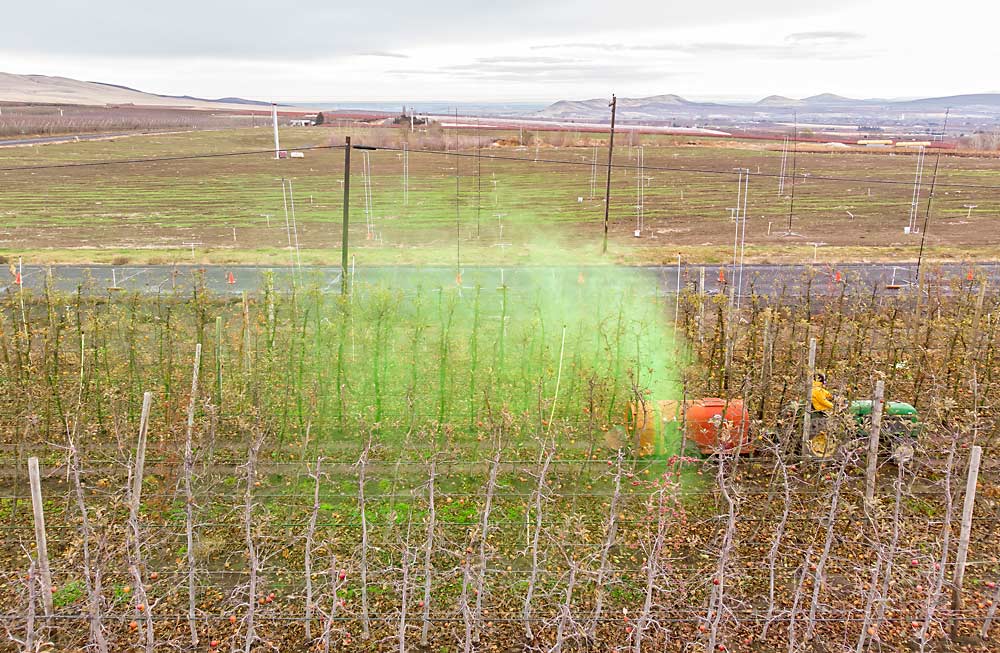
Against the gray, late-autumn sky, it’s hard to miss the green plume spraying into the dormant orchard.
It’s a very colorful solution to a nearly invisible problem.
Underlying every pesticide label regulation lie complex calculations of risk to protect workers, bystanders and the environment from drift. But the methods federal regulators use to determine drift allowances from airblast sprayers date back decades — and likely overestimate the risk in modern orchards.
“All the restrictions and statements on labels are based on a set of assumptions of a worst-case scenario,” said Washington State University extension specialist Gwen Hoheisel. “If we could have a better estimate and the worst-case scenario is not actually as bad as it’s currently estimated, it could lead to less restrictive labels.”
That’s why Hoheisel, WSU agricultural engineer Lav Khot and a team of research associates were eager to watch the path of that fluorescent green cloud from the airblast sprayer. To the naked eye, little drift beyond the orchard block could be seen. However, dozens of drift samplers transecting up to 600 feet across the adjacent field were poised to catch and measure any particles that reached them.
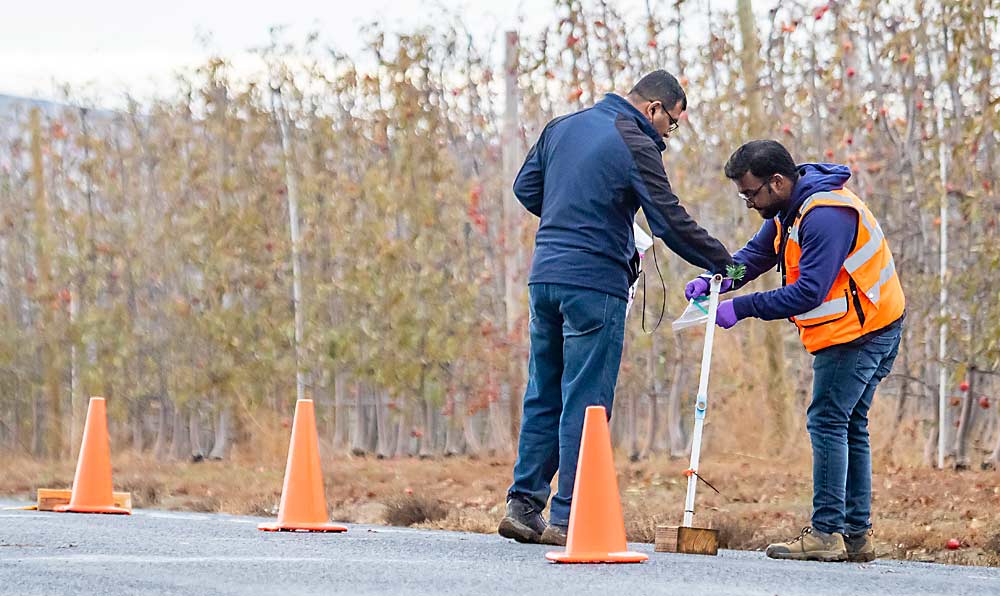
The data collected on those samplers, combined with weather station data about the precise conditions at the time of the spray, will be fed into a new model to more accurately assess drift risks. It’s hoped that new model will benefit growers by preventing unnecessarily conservative labels in the future.
Growers funded the data collection through the Washington Tree Fruit Research Commission, after manager Mike Willett explained how continuing to rely on the Environmental Protection Agency’s existing methodology could be bad for business.
Currently, the model relies on a worst-case-scenario curve that assumes all sprays are on dormant trees.
“For example, with carbaryl (Sevin), they are assuming that you are making carbaryl applications when there are no leaves on the trees. And that just doesn’t happen,” Willett told commissioners at the apple crop protection research review last year.
The $164,000 grant from the commission to WSU for drift data gathering in 2018 and 2019 builds on previous work the commission started in 2017 with roughly $320,000 from the Washington State Specialty Crop Block Grant program, the U.S. Department of Agriculture and the U.S. Forest Service.
The funding supported development of a new model that reflects different canopy sizes, sprayer types, nozzle positions, droplet sizes and weather conditions. That mathematical model now needs the real-world data from WSU’s trials to validate it.
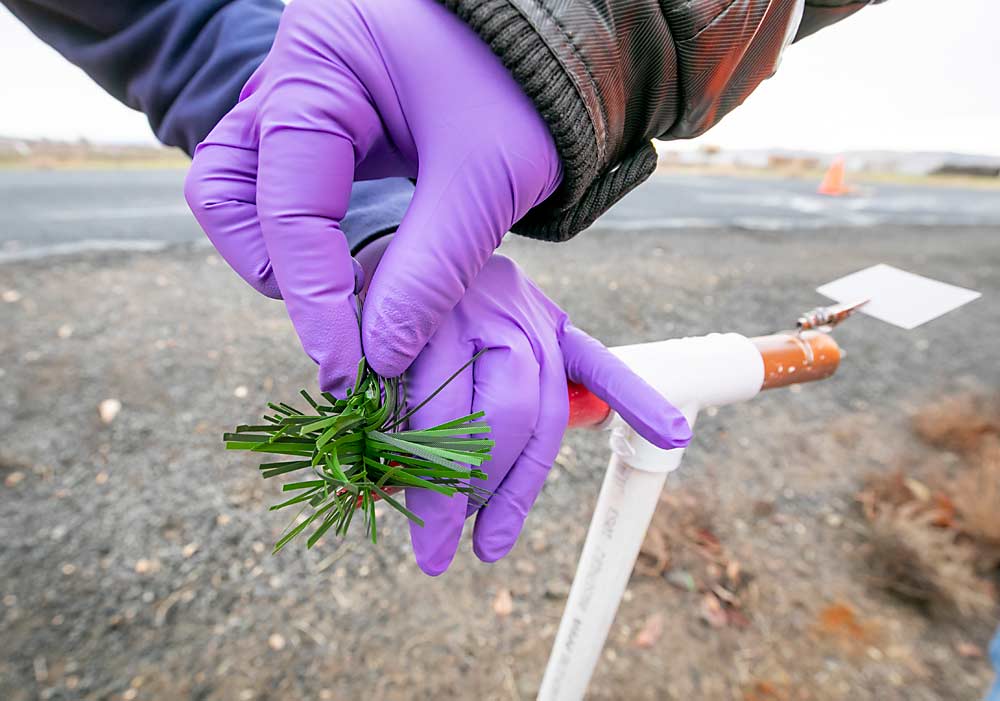
“Data collection and model writing costs a lot of money, but growers are starting to understand that regulations will be unrealistically restrictive unless they update the model,” said Harold Thistle, a drift modeler who leads the work to build the new airblast sprayer model. He recently retired after a career working with pesticide drift models for the Forest Service.
The Forest Service and most row crop growers who apply pesticides via aircraft benefit from what’s called a mechanistic model for aerial applications. That model takes dozens of variables into account to more accurately estimate drift risk, Thistle said.
But for orchard work, the ag chemical industry players that adopted the mechanistic aerial spray model never got around to an airblast model, he said. In lieu of such a model, the EPA relies on data from drift field work done 25 years ago, and as the agency lost confidence in the out-of-date data, it has made increasingly conservative assessments of risk for tree fruit, citrus, nut and grape growers.
“Given their mandate to protect human and environmental health, the EPA has reverted to what is infamously called the dormant apple curve,” Thistle said. “Of course, if you spray dormant apples, you don’t have any foliage to intercept the spray, so you get the highest drift.”
By contrast, Thistle plans to learn from the data WSU collects in high-density apple orchards and to validate the new mechanistic model with different risk predictions for dormant, partial and full canopy positions.
The tree fruit industry is the first to fund this data collection necessary to validate the new model, but Willett and Thistle hope to build support from citrus, almond and wine grape growers to repeat the data collections.
As of January, the California grape industry was considering supporting a data collection effort, but nut and citrus growers had not yet made a commitment, Willett said.
Grape growers stand to gain the most from better drift assessment, Willett said, since the current EPA approach assumes grape growers are also spraying a dormant apple canopy. In reality, vineyards have an order of magnitude less drift, since sprayers aim down at the canopy or use over-the-row technology, he said.
The California Environmental Protection Agency is also interested in the new model, Willett said. Currently, it sets regulations assuming pesticides are applied by aircraft, because the aerial drift model provides estimates of air concentration for each chemical.
“They get that they are likely overpredicting,” Willett said. “If I were subject to pesticide regulations in California and I heard that, I would immediately think, ‘How do we fix this?’”
The model will require validation data from each commodity type before it can be used for those crops, but it could be finished only for use in tree fruit if other commodity groups decline to participate.
Validation requires 20 spray trials in each crop scenario. Fluorescent tracer dye can then be washed and extracted from the samplers — paper cards, small pieces of fake foliage, such as from an artificial Christmas tree, and strings stretching 25 feet high — for measurement in the lab, Khot said. Researchers set up the sprayer based on best management practices for a tall spindle orchard.
Khot and his team will be back to run the same trials this summer, when the orchard has a full canopy.
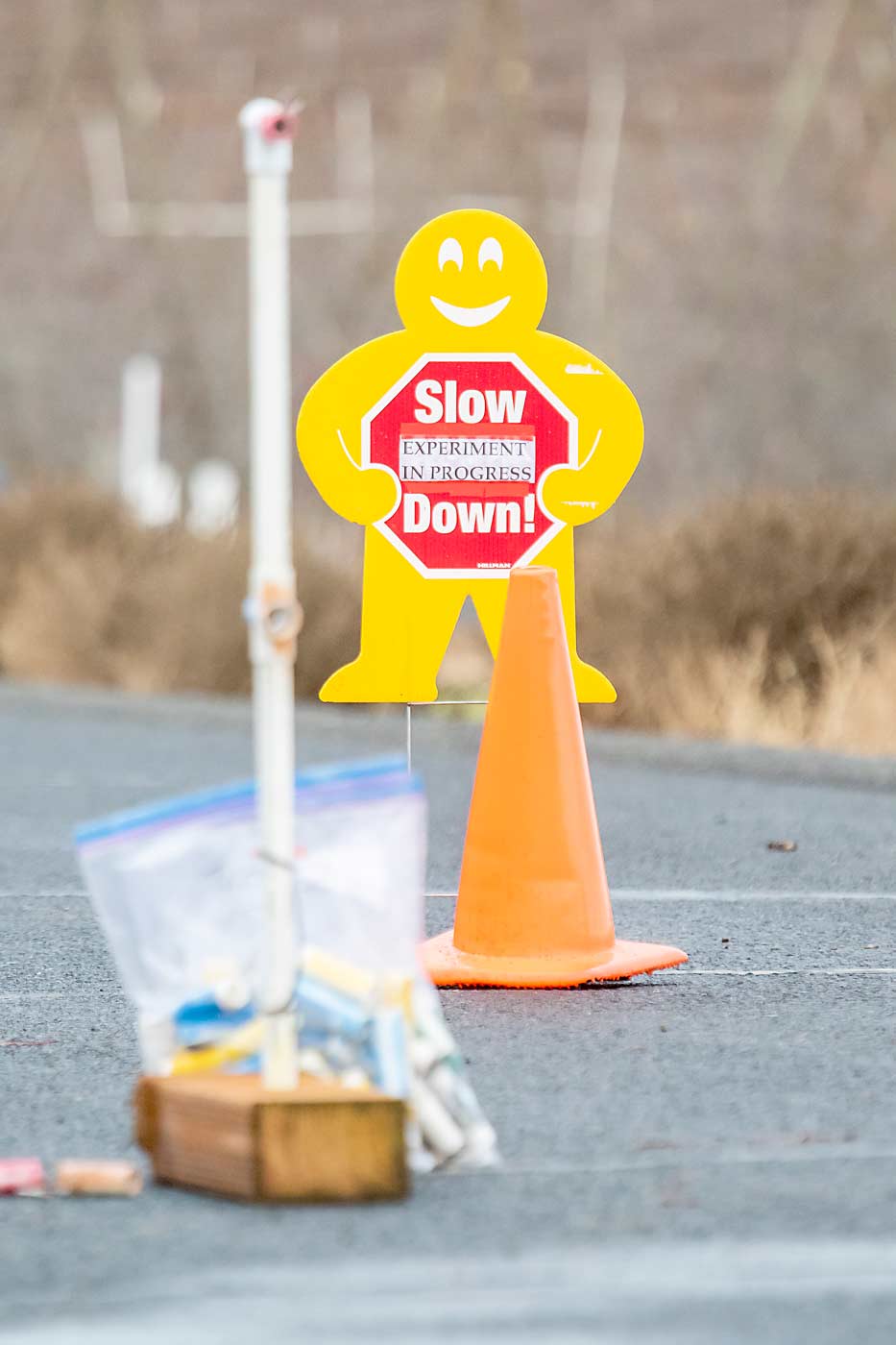
“Model building can be tricky. No pun intended: We need to compare apples to apples,” Thistle said. So, he and his collaborator, particle physicist Milt Teske, have worked with the EPA to ensure the model will satisfy their regulatory requirements.
“We’re trying to get a more real approach and we hope it’s going to help everybody,” Thistle said, referring to both regulators and growers.
Once equipped with this mechanistic model, the EPA would be able to write regulations that better reflect drift risks from today’s spray technology and also incentivize further investment in drift reduction technology, Hoheisel said.
“The tree fruit industry is migrating to low-drift technology,” she said. “The benefit to growers is better crop protection and less culls. But with less drift occurring, minimizing that risk factor with better technology, growers might benefit from different regulations that recognize better practices.”
That’s the long-term goal. And while buffer zones are unpopular with growers, the EPA’s shift toward buffers may actually help make drift reduction efforts pay off, Thistle said. If low-drift technology enables regulators to replace a requirement for a 100-foot buffer with a 25-foot buffer, that’s a strong economic incentive.
“Buffer zones can really take a lot of land out of production and if they are using the conservative models, it can really hurt (growers),” Thistle said. “Twenty years ago, people said, ‘Why should I invest money in doing it better?’ But buffers may actually incentivize using better spray technologies.”
There’s no guarantee the new drift model would be used this way by regulators, but everyone involved remains optimistic that a better assessment of risk will ensure that future regulations aren’t unnecessarily conservative. •
—by Kate Prengaman / photos by TJ Mullinax
Related: Steering the research on spray drift




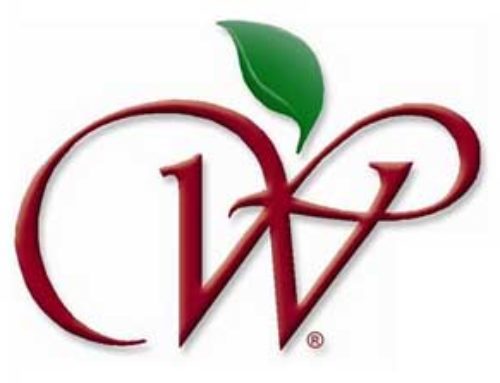

Leave A Comment